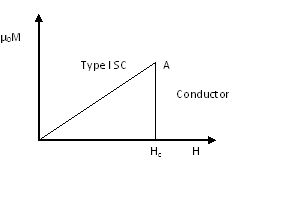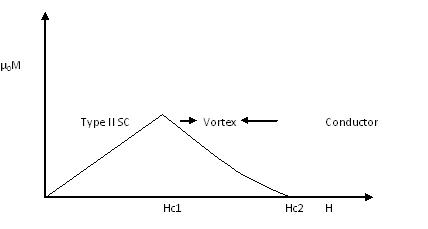Type I and Type II superconductors
Depending upon their behavior in an external magnetic field, superconductors are divided into two types:
a) Type I superconductors and b) Type II superconductors
Let us discuss them one by one:
1) Type I or Soft superconductors:
The following is the definition and Properties of Type I or Soft Superconductors:
a). Type I superconductors are those superconductors that lose their superconductivity very easily or abruptly when placed in the external magnetic field. As you can see from the graph of the intensity of magnetization (M) versus applied magnetic field (H), when the Type I superconductor is placed in the magnetic field, it suddenly or easily loses its superconductivity at the critical magnetic field (Hc) (point A).

After Hc, the Type I superconductor will become a conductor.
b) Type I superconductors are also known as soft superconductors because of this reason that is they lose their superconductivity easily.
c) Type I superconductors perfectly obey the Meissner effect.
d) Example of Type I superconductors: Aluminum (Hc = 0.0105 Tesla), Zinc (Hc = 0.0054)
2) Type II or Hard superconductors:
The following is the definition and Properties of Type II or Hard Superconductors:
a). Type II superconductors are those superconductors that lose their superconductivity gradually but not easily or abruptly when placed in the external magnetic field. As you can see from the graph of the intensity of magnetization (M) versus applied magnetic field (H), when the Type II superconductor is placed in the magnetic field, it gradually loses its superconductivity. Type II superconductors start to lose their superconductivity at the lower critical magnetic field (Hc1) and completely lose their superconductivity at the upper critical magnetic field (Hc2).

b) The state between the lower critical magnetic field (Hc1) and upper critical magnetic field (Hc2) is known as vortex state or intermediate state.
After Hc2, the Type II superconductor will become a conductor.
c) Type II superconductors are also known as hard superconductors because of this reason that is they lose their superconductivity gradually but not easily.
d) Type II superconductors obey the Meissner effect but not completely.
e) Example of Type II superconductors: NbN (Hc = 8 x 106 Tesla), Babi3 (Hc = 59 x 103 Tesla)
f) Application of Type II superconductors: Type II superconductors are used for strong field superconducting magnets.
there is a simple mistake on the last part of type II superconductors
you are still writing that type one yet we on type II already
but it great stuff
Thanks for the pointing the mistake. I have corrected it now.
Hi, I am a student, can I use the information for a presentation and seminar in my college.
yes, you can use but give the reference of our website.
Thanks you sir, for teaching in easy language, it was very helpful for me…thanks you so much .. & i request this website owner to published this types articles more & more in easy language( simple word, usually books write huge in complex word)… Finally one again Thanks
.. & i request this website owner to published this types articles more & more in easy language( simple word, usually books write huge in complex word)… Finally one again Thanks 